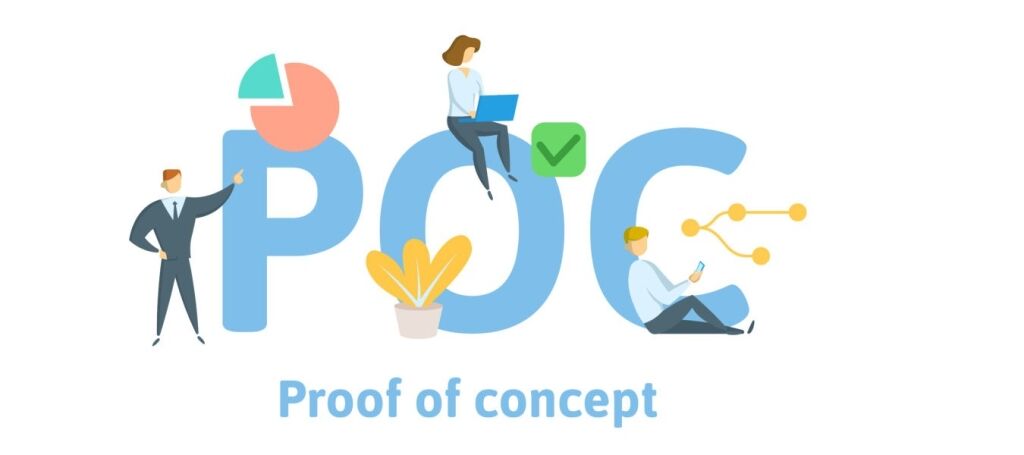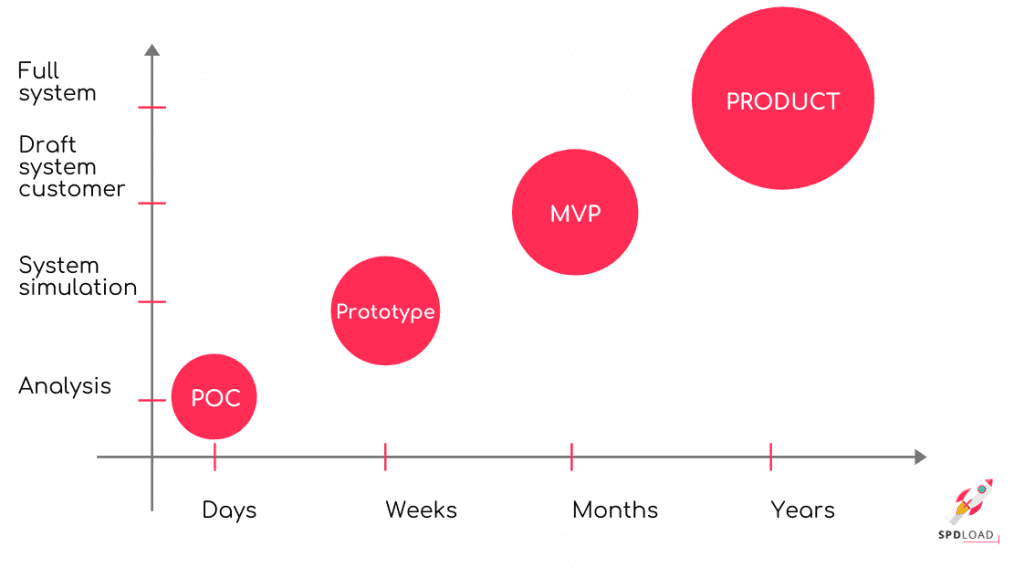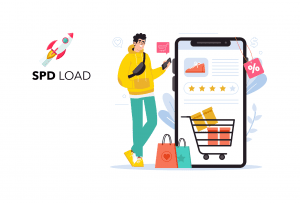Proof of Concept vs Prototype vs MVP
- Updated: Aug 27, 2024
- 11 min
Proof of concept (POC), prototyping, and minimum viable product (MVP) are common terms used frequently in software development.
But what do they actually mean? How can you use them to grow your business? And what sets them apart?
In this article, we’ll discuss the purpose and key differences between these three product development strategies.
We’ll cover topics like:
- Brief definitions of each strategy
- The main reasons companies rely on them
- Key differences and use cases
- How to select the right approach for your goals
By the end, you’ll have a simple yet nuanced grasp of POCs, prototypes, and MVPs so you can confidently incorporate them into your product roadmap.
Sound good? Let’s get started!
Unlock your startup potential now — start transforming your vision into a scalable solution with our expert developers today!
Proof Of Concept
What is a POC? POC is an acronym that stands for proof of concept. It is a project implementation approach that helps to find out if the idea is feasible. A successful proof of concept in the custom software development industry confirms that the idea will function as designed. Startups may use POC as a financial viability aspect.
A proof of concept is not a simplified version of your product. It is a stand-alone project that only shows if your idea is possible to implement.
This strategy is not about identifying the idea market demand. It doesn’t expose the most efficient production process. A POC project covers only the technical capabilities of a project.
Each POC enables you to verify whether one of your tech assumptions, concepts, integrations etc. can be implemented. Thus, if you need to verify two technical aspects in different parts of your project, you will need two proof of concept POCs.
A POC doesn’t presuppose a perfect development, because it isn’t likely to be reused. Its essential aspects are hard-coded data, mocked APIs, etc. You can neglect code quality, security and simplify the user interface.
You should build up your POC project before prototyping and MVP development. A proof of concept methodology usually requires time and resource investment. But developing an unfeasible product always leads to heavy expenses.
How a Proof of Concept Works in Software Development
If you are uncertain about the feasibility of a product idea, concept proofing has two possible answers—yes or no. A negative reply will prevent you from proceeding with a potentially inviable project. If your idea has a positive proof of concept, you can continue to build your project.

Proof of concept process flow or results are not meant to be shown to your users. It is an internal approach to solving critical issues. However, showing it to your potential investors, in turn, can help you raise seed funding. Thus, you can show that you are a heavy hitter with a technically workable idea.
To know how a POC stage can improve your business, check the essential features of the approach.
Key Proof of Concept Features
A POC has several main features. They are:
- Lets you know whether or not your idea is feasible
- Allows you to explore the idea potential to be build
- Enables you to see how a small fragment of your project can be implemented
- Unveils main risks and bugs occurring at the early stage of development
- Is a more time- and cost-saving solution for feature validation than a full-blown project
- Provides only two possible final answers — yes or no
Main Reasons to Use a Proof of Concept
Usually companies that use POC want to find out whether their idea is feasible. An innovative idea always creates uncertainty and, thus, may require testing. The same applied to developing a solution similar to an existing one at low cost. The competitors idea could have been implemented with higher investment than you have. That is why, it is better to use a POC approach to check your idea viability.
Concept proofing is not a necessary part of the development process. Still, I recommend it if you have technical points that need to be solved beforehand.
Prototyping
Once you get a positive result of the proof of the concept, you can start prototyping.
Prototyping definition in software engineering refers to the strategy that allows one to see how the product will look after development.
If a POC is about technical part, a prototyping deals with UI/UX. It allows to visualize the way the end-user will interact with your product. The purpose of the prototype is to make you understand the project workflows and define which features to include in it. Learn more about the differences between UI vs UX design.
The prototype development process lies in designing a set of web or app screens (if you choose mobile app development) to make up a model of your product. It exposes the errors in study and design through the work of project managers.
Prototyping is about developing an early model of a product that can be tested and reworked until the expected results are achieved. As well as a POC, prototyping has a short lifecycle.
How Prototyping Works
How to build a product prototype? A product owner defines all system requirements to create a preliminary simplified design. Then, the first prototype is developed and tested. Once the main errors and strong points are identified, the developer evaluates feedback. It is time to decide on what should be added and removed.
Each new prototype leads to the development of a new system. The following system development is iterated until its final version meets all the requirements and user satisfaction.
This approach is the most widespread. However, the process flow may be altered according to the chosen prototyping type.
Types of Prototype Models

There are four prototyping model types:
- Rapid
How rapid prototyping works? The developer build a prototype taking into account the preliminary requirements. Rapid prototype development is a quick solution, which is afterwards revised via the user feedback. Moreover, each prototype can be discarded and may not be a part of the final product.
- Evolutionary
It presupposes a continuous step-by-step prototype development. Each prototype is a sequel of a previous one, improved in accordance with user feedback.
- Incremental
The final project concept is divided into small parts. Each of them has its own prototype, which should be developed and tested. In the end, all of these prototypes are merged into the final product.
- Extreme
This model is used specifically in the field of web development trends. The developers build multiple web prototypes in an HTML format with a services layer. Once all of them are tested, they are integrated into the final product.
Key Features of Prototyping
What does the prototype stand out for? Here are its main features:
- Allows to get early user feedback on the product
- Lets you identify the design and development mistakes
- Is more time- and cost-saving solution compared to full-stage development
- Provides users with a better understanding of the product workflow
- Makes it easier to identify customer needs
- Brings complex ideas in one comprehensive format
- Can be used again in the next, more complex projects
Main Reasons to Use Prototypes
A prototype product development can become particularly useful. Especially in case some project requirements still lack in details. You can create mockup screens to see and feel how your product will look like. The main benefits of prototyping lie in an opportunity to interact with users and gather feedback. An improved and revised prototype that corresponds to the user needs is the best way to start your MVP.
MVP
What does MVP in business mean? MVP stands for a minimum viable product. An MVP version has enough features to convey its idea to early adopters and solve their problems.
Unlike POC or prototype, an MVP is a functional product that has a minimum set of features to satisfy the needs of its initial users. An MVP lets you find out how your customers would accept your product. What is the point in wasting money and resources on something they aren’t interested in or don’t need?
Your minimum viable product MVP should include only the features that make your solution valuable for the customers. And the only question an MVP raises is “Will users pay for my product?”
Unfortunately, unlike with a POC, the answer is usually not as plain as “yes” or “no”. A minimum viable product gives room for learning, enhancing, and analyzing.
A minimum viable product gives a clue on how to develop a good enough product in a short space of time. It is not a full-scale product with a complete user interface but it is a helpful approach to test your product in the market.
On the one hand, you spend less money than if you were developing a final product. On the other hand, you get user testing and feedback, understand the demand, and can finally start defining your business model. There are no drawbacks and no blind spots.
An MVP stage was once used by companies such as Uber, Airbnb, and Dropbox. An MVP is not about making an inferior product. It is about allowing users to bite off your product and decide whether they want to swallow it. With this knowledge, you decide on the further development path.
Key Features of an MVP
The MVP development service has several features:
- Makes a product ready for release in a relatively short time
- Lets you develop a product with a chosen set of features essential to cover users’ needs
- Is a short form of your product, with a core but gives you the ability to grow
- Helps to prevent waste of development costs, efforts, and time. Learn more about how much does it cost to build an MVP.
- Unveils the most efficient direction for further development
- Helps to verify product viability and assumptions
- Reduces risks
- Gives an understanding of product usability and market demand
- Allows to get a high retention rate with relatively small investments
Main Reasons to Use an MVP in the Development Process
Entrepreneurs rarely like talking about failures, but we witness them once in a while. The reasons for that may vary. But the fact is, if my product is bound to fail, I want to know it as soon as possible. That is the first reason I have always preferred to choose an MVP way.
An MVP is the fastest and most reliable way to give target audience a solution for its problem. 42% of projects with an innovative product idea fail because of the long development time. It happens because they don’t launch an MVP and don’t get a potential client’s feedback.
If people don’t like the solution, an MVP is a quickest way to know it and save resources. In case they are ready to pay for it, an MVP makes it possible to choose the right direction to extend.
Whether you’re a startup or a seasoned pro, this guide on MVP design will save you time and money.
MVP vs Prototype vs POC: What to Choose
The difference among these three strategies has become clearer. But there is still a room for a user testing.
What We Have
There is no need to decide on the strategy right now. Let’s take a break for a moment and think about what we’ve got by now. Here are the main points you need to know for sure before starting to choose a strategy:
- Your target audience
- The advantage of your solution
- Your validation criteria
- The part of the product development that needs verification
- Your purpose
- An estimated budget, timing and resources
- Your vision of target output for product readiness and functionality
If there is an unsolved issue in this list, take your time to clarify it.
Get a strategic MVP to mitigate risks.
Comparison: MVP vs Prototype vs Proof of Concept
Three considered strategies have different purposes and parameters. Here is a clear illustration:
| SPECIFICATION | POC | PROTOTYPING | MVP |
| Answers the Question | Is my idea technically feasible? | How will my product look like and be used? | Will my product be viable? |
| User Interaction and Target Audience | Is meant to be used internally | Shows the user how the product will look like. The target audiences are usually the stakeholders | Gives a user an opportunity to test a product. The target audience is a pre-selected group of potential customers |
| Risk Evaluation | Reduces the risk of a technical problem during development | Reduces the risk of user dissatisfaction with the product workflow | Reduces risks of losing more time and resources on development |
| Main Purpose | To identify the technical feasibility of the idea | To visualize a product and show it to stakeholders | To provide a short-form functional version of the product that can be launched on the market |
| Technical Resources Investment | Needs some investment | Needs a minimum investment of technical resources | Needs relatively high technical resources investment |
| Cost-Effectiveness | Allows to get internal funding with a small budget | Needs a minimum budget | Needs an estimated budget and allows to find an investor |
| Salability | Is not meant to bring revenue | Is not meant to bring revenue | Can bring revenue via the early users purchases |
| Further Use | Can be used for an MVP development | If it includes UI design, it can be used in development | Can be extended to the full version of the product |
Cheatsheet
MVP, prototyping, and POC are the strategies that can be applied in sequence. However, a product owner may not want to use them all or experience a lack of resources. That is why I’ve made a list of preconditions that will help you choose.
| Precondition | Recommended Strategy |
| I want to show users a functional product with built-in features. | MVP |
| I am limited in money and time to show my project to the stakeholders or end-users. | PROTOTYPING |
| I want to have a polished product that works without errors before launching it on the market. | MVP |
| I want to launch a product and make a profit instantly. | MVP |
| I want to visualize my project and know how it would work even if there may be errors. | PROTOTYPING |
| I need to know if potential clients accept my product and are ready to enhance it. | MVP |
| I want to understand and feel how my product works before developing it. | PROTOTYPING |
| I don’t want to invest many resources, but I have the ability to achieve a high retention rate. | MVP |
| I am not sure if my idea is technically workable. | POC |
| I am limited in technical resources, but I want to know how my product will work. | PROTOTYPING |
| I need to have seed-stage funding at an early stage. | POC / PROTOTYPING |
| I have a small project that needs both funding and approval of technical feasibility. | POC |
| I need to explore the technologies used in my project. | POC |
| I want to attract investors. | POC / PROTOTYPING / MVP or all of them together |
| I have to make sure the features or the whole project will run smoothly before development. | POC |
Conclusion
As you can see, the POC, prototyping and MVP strategies can be used solemnly and together. They have different purposes and are applied at different stages of development. Thus, they are not interchangeable. 
Of these three, only an MVP is a functional product. But it doesn’t mean that two other strategies don’t influence an MVP or full-stack development.
If you have an idea, especially an innovative one, a POC is there to help you in finding out whether you can technically implement it. Without a POC, the development of a product is like taking a wild guess and win.
Prototyping is more about having not only a vision, but an ability to feel your product. If you have enough resources, you can build up a UI design during the prototyping process. Later you can use it in development.
You can use these strategies stage-by-stage, right after your idea validation. Otherwise, you can implement it in your development, proceeding from your purposes.
Ready to Build an MVP?
There you have it – a breakdown of proof of concept vs. prototype vs. minimum viable product.
While they share some similarities, understanding the nuances of each development method is key to selecting the right approach for your specific product and business goals.
Our team offers end-to-end development services specialized around building POCs, prototypes, and MVPs.
Reach out for a free consultation to discuss your project specifics. We’ll recommend whether a POC, prototype, or MVP makes the most sense as your next step.






